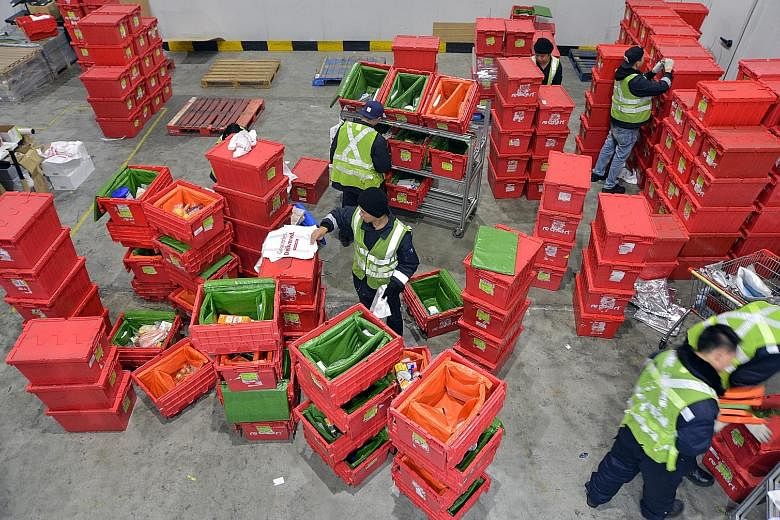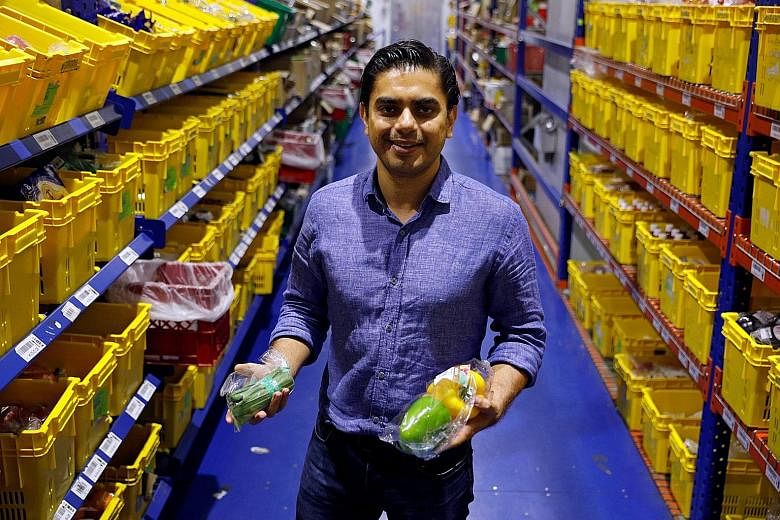From a warehouse perched on the edge of a potentially vast new market for online shopping, the Alibaba Group of China hopes to beat Amazon one head of lettuce at a time.
Under the glare of fluorescent lights, green-vested workers carefully wrap fruit, cheese and other perishables for delivery by vans to a growing group of Singaporeans who prefer to do their shopping online.
"It's getting better and better," said Mr Vikram Rupani, president of RedMart, an online grocery company based in Singapore that is part of Alibaba's push into the region, "but it's a continuous process that never ends."
Alibaba and American giant Amazon already dominate online retail in their home markets. Increasingly, they are competing against each other on neutral ground.
Alibaba's bigger bet is in South-east Asia. It has spent more than US$2 billion (S$2.7 billion) to take control of Lazada, a five-year-old online shopping company based in Singapore and doing business in six countries. Last year, Lazada bought RedMart, the online retail grocery.
The promise is there, as the region's young middle class grows and goes online. South-east Asia's e-commerce sales could total US$88 billion by 2025, projections from Google and Temasek Holdings, the Singaporean sovereign wealth fund, show. Volume was less than one-tenth that in 2015.
Alibaba and Amazon are seeking consumers like Singaporean Janice Lee Fang, who decided she needed to buy a robot to amuse her six-year-old daughter home sick from school. Through Amazon's Prime Now service, introduced in Singapore in July, she bought a Sphero SPRK Plus - a clear plastic ball that can skitter across the floor with a tap of a smartphone - that arrived in less than a day.
But South-east Asia is no China. A diffuse area of 600 million people, the region is divided by politics, language and culture. Some places are modern, like Singapore. Others lack the roads and other infrastructure to get people what they need.
The challenges have forced Lazada, Alibaba's biggest South-east Asian operation, to be creative.
In Vietnam, local post offices take customer returns and give cash refunds. In Malaysia, customers can collect merchandise from lockers at 7-Eleven stores. And in the Philippines, Lazada uses petrol stations as places where merchants can drop off their goods for delivery personnel to pick up.
Alibaba's international arm has seen its latest quarterly sales more than double in a year, in part from Lazada's contribution. Still, Lazada and its RedMart subsidiary remain a tiny, and unprofitable, part of Alibaba's empire. Lazada's chief executive Max Bittner said its Chinese parent has been willing to spend money to build its delivery capabilities and draw more customers.
"E-commerce is an economy-of-scale game," Mr Bittner said. "I can go after this opportunity with the amount of firepower I need."
Amazon so far counts Singapore as its only South-east Asian market, though industry experts expect it will expand into other countries.
Until recently, direct Alibaba-Amazon rivalry has been rare. Amazon has a modest presence in China. Alibaba sells goods in the United States through its AliExpress platform but has backed away from further expansion efforts.
South-east Asia could offer a test of their vastly different business models on neutral turf.
Amazon owns more of the inventory it sells. By contrast, most of Lazada's sales are from outside vendors who use its platform as a digital middleman to reach customers. That approach, which keeps costs low, is similar to what Alibaba does in China. But in China, the company's Taobao platform has been accused of offering counterfeit goods. Alibaba says it is working to fight fakes.
NYTIMES


